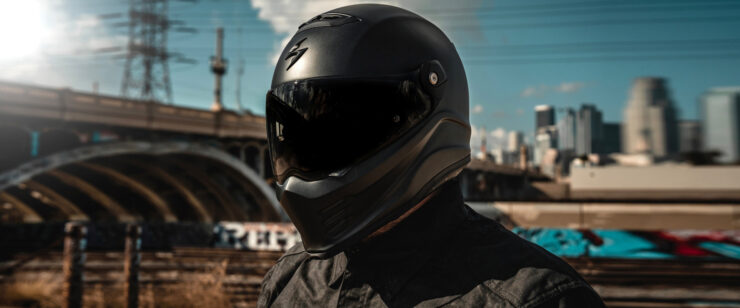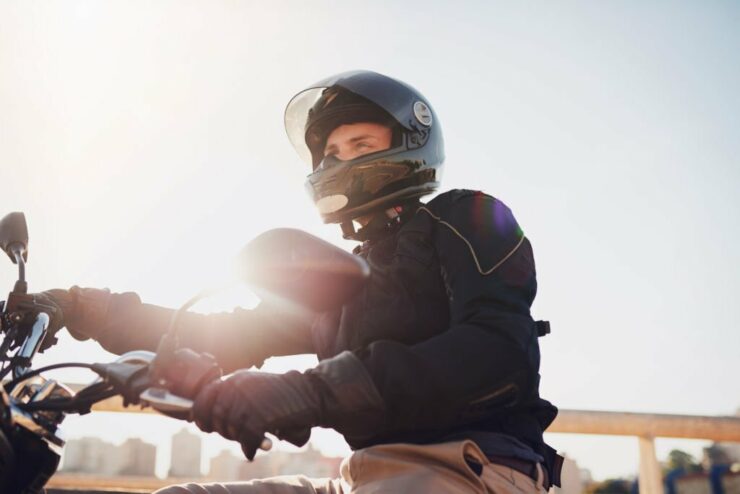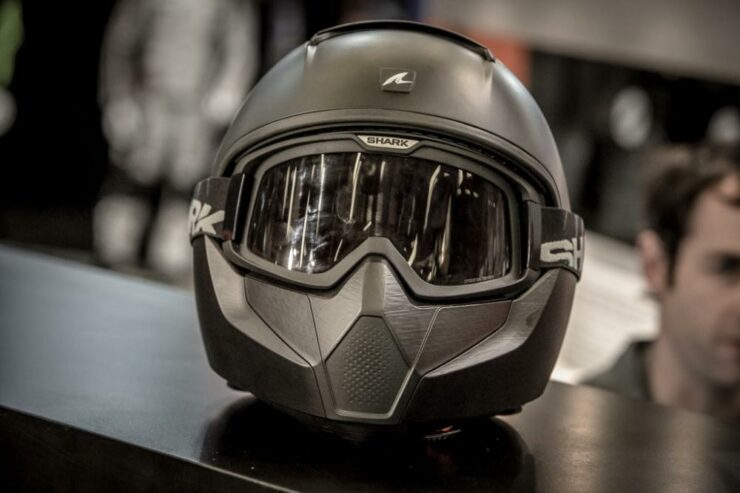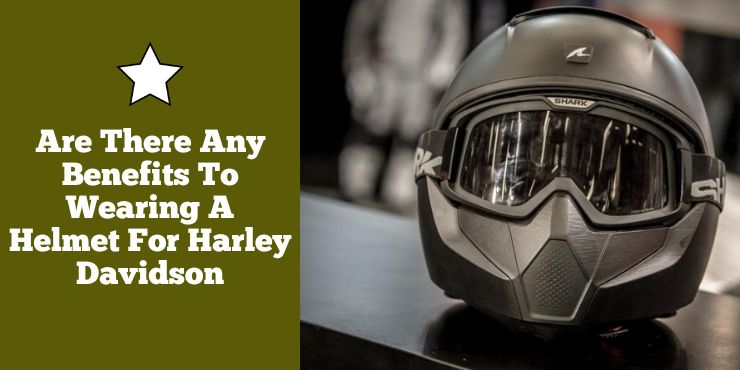Riding a Harley-Davidson is an iconic American experience that many motorcycle enthusiasts enjoy. But, is there any benefit to wearing a helmet while you’re out for a ride?
Wearing a helmet reduces the risk of head injuries, protects against weather and debris, and often improves aerodynamics, enhancing rider safety and comfort.
In this article, we’ll explore the potential advantages and disadvantages of wearing a helmet while riding a Harley-Davidson. Whether you are a veteran Harley-Davidson rider or considering taking the plunge, this article will provide you with the information you need to make an informed decision. So, grab your helmet and let’s get started!
Role of motorcycle helmet for a Harley-Davidson rider
Harley-Davidson is a brand that goes hand in hand with freedom, adventure, and an iconic sense of style. As bikers hit the open road on their powerful machines, it is important to prioritize safety. One of the most important pieces of motorcycle gear is a motorcycle helmet. Helmets are essentially the first line of defense when it comes to protecting the rider’s head in the event of a collision or accident.
>>> Click here to read our review of the Best Helmet For Harley-Davidson <<<
The strong outer shell, impact-absorbing liner, and secure chinstrap of a quality helmet work together to minimize the risk of severe head injuries, such as concussions, skull fractures, and traumatic brain injuries. For Harley-Davidson riders who crave the thrill of the road, wearing a helmet is an important safety measure that can save lives and prevent life-altering injuries.
A motorcycle is also responsible for improving visibility and helping with communication. Modern helmets for Harley-Davidson bikers often come equipped with features that enhance visibility and communication. Many helmets feature built-in visors or face shields that protect the rider’s eyes from debris, wind, and harsh weather conditions while also offering a clear vision of the road ahead.
Moreover, helmets with built-in communication systems or Bluetooth connectivity allow riders to stay connected with fellow riders, receive navigation instructions, or take phone calls hands-free. These features will help you enjoy a safer riding experience, as you’ll be able to stay focused and maintain situational awareness without compromising safety.
Further, it also protects you from external elements. Harley-Davidson bikers embrace the open road as they’re exposed to the elements as they feel the wind rush past. However, helmets offer protection against various weather conditions, keeping riders comfortable and focused on the ride. Helmets having appropriate ventilation systems, allow airflow to prevent overheating during hot weather while also shielding the head from rain, cold temperatures, and flying debris. By wearing a motorcycle helmet, you will be able to enjoy your Harley-Davidson experience with added comfort and protection.

Are there any benefits to wearing a helmet for Harley-Davidson riders?
When riding a Harley-Davidson motorcycle, the feeling of freedom and the thrill of the open road is unparalleled. However, it cannot be understated how pivotal it is to make sure you keep your safety in check. Amidst the excitement of driving a Harley, it is important to prioritize safety, and wearing a helmet plays a key role in protecting your well-being and making sure you ride in style. Helmets are not just fashion accessories as they also offer a wide range of benefits.
Here are some of the primary benefits of wearing a helmet when driving a Harley-Davidson bike. Understanding these benefits will help you understand the importance of wearing a helmet each time you hit the road on your Harley-Davidson bike.
#1. Improved safety
Riding a Harley embodies adventure and power but it is important to acknowledge the potential risks on the road. You must keep yourself away from any risk of injuries and accidents. The primary benefit of wearing a helmet is to protect the rider’s head in the event of an accident or collision. Helmets are designed with a robust outer shell and an impact-absorbing liner that work together to mitigate the force of an impact and minimize head injuries.
A helmet also safeguards the rider’s skull, reducing the risk of severe trauma, skull fractures, and other traumatic injuries. By acting as a barrier between the head and potential hazards, helmets significantly improve the safety of motorcycle riders. By wearing a helmet, you’ll be able to prioritize your safety and well-being, allowing you to enjoy the thrill of your Harley-Davidson motorcycle with peace of mind.
#2. Enhanced comfort
Modern helmets have come a long way in terms of design and construction, placing a strong emphasis on rider comfort. Helmets now come in different shapes and sizes to accommodate different head shapes and ensure a snug fit. The helmets in today’s market have been designed with rider comfort in mind. They incorporate features like ventilation systems, adjustable straps, and padding to enhance comfort during long rides.
The interior padding and lining cushioning help absorb sweat, reducing discomfort during long rides. Ventilation systems allow for adequate airflow, keeping riders cool and preventing excessive heat buildup. The ability to adjust chin straps and visors adds to the overall comfort and customized fit of helmets, allowing riders to focus on the road ahead. Helmets with proper ventilation also prevent overheating and excessive sweating, keeping you cool and focused.
The snug fit and cushioned interior reduce wind noise, reduce fatigue, and allow for an enjoyable ride. By wearing a helmet, you will be able to optimize your riding experience by prioritizing comfort and minimizing distractions.
#3. Improved visibility
Clear visibility is important for safe riding and helmets play a key role in enhancing the rider’s visual capabilities. Helmets come equipped with visors or face shields that protect the rider’s eyes from wind, dust, debris, and harmful UV rays.
These shields are typically designed with anti-fog coatings to prevent condensation, ensuring uninterrupted visibility in various weather conditions. Moreover, some helmets feature built-in sun visors or tinted shields to shield the eyes from bright sunlight, reducing glare and enhancing visibility on the road. By providing a clear field of vision, motorcycle helmets contribute to safe riding experiences.
#4. Shield your eyes from external environmental elements
Riding a motorcycle helmet exposes riders to various environmental factors such as wind, dust, and flying debris. A helmet acts as a shield, protecting your eyes, face, and head from these potential hazards. Further, it also minimizes the risk of eye irritation, prevents dust particles from obstructing vision, and shields against harmful UV rays. By wearing a helmet, you’ll be able to maintain clear visibility and shield yourself from external elements, allowing you to fully embrace the ride on your Harley-Davidson bike.
#5. Helps you comply with legal requirements
Wearing a helmet while riding a Harley isn’t just a matter of personal safety, it is often a legal requirement. Many jurisdictions have laws that mandate helmet use for riders of all motorcycles, including Harley-Davidson bikes.
Complying with these regulations will help you ensure that you avoid legal penalties, protects your riding privileges, and uploads the integrity of a responsible motorcyclist. By wearing a helmet, you’ll be able to demonstrate respect for the law and set a positive example for other riders.
Harley-Davidson riders are often seen as ambassadors for the motorcycle community, attracting attention and inspiring others to take up the hobby. By donning a helmet, you’ll be able to set a positive example for safety-conscious riding, showcasing responsible behavior and emphasizing the importance of positive gear. Encouraging the culture of helmet use among fellow bikers can help contribute to safer roads and reduce the stigma surrounding helmet-wearing.

Different types of motorcycle helmets for a Harley-Davidson biker
Harley Davidson bikes are iconic symbols of freedom, power, and style. As a Harley-Davidson rider, it is important that you should prioritize safety by wearing a sturdy motorcycle helmet. When it comes to motorcycle helmets, riders have an impressive range of options to choose from, with each type of helmet having its own unique features and benefits. With such a wide range of options at your disposal, you’ll be able to find out what suits your preferences and riding style. Here are the different types of motorcycle helmets specifically suited for Harley-Davidson riders, ensuring both protection and a touch of Harley-Davidson style.
#1. Half helmets
Half helmets or also known as shorty helmets or skull caps are known for their minimalist design and lightweight design as they offer minimal coverage while emphasizing a sense of freedom and style. These helmets cover only the top of your head, leaving the face and lower parts of the head exposed, which means there is limited protection to the sides and back.
Half helmets offer maximum ventilation and a sense of freedom, allowing the rider to fully experience the wind in their face. Although half helmets offer less coverage than other helmet types, they remain a popular choice among Harley-Davidson bikers who prioritize style and live in regions with less stringent helmet laws. These helmets often feature Harley-Davidson’s signature designs, allowing riders to showcase their love for the brand.
They’re quite popular among bikers who prefer a minimalist design and maximum ventilation. These helmets are lightweight and they allow for a greater sense of openness and a better view of the surroundings. However, it is important to note that these helmets provide less coverage and protection compared to other types of helmets, leaving the face and lower parts of the head exposed.
#2. Open-face helmets
Open-face helmets or also known as three-quarter helmets offer greater coverage than half helmets while maintaining a full sense of freedom and openness. Similar to half helmets, open-face helmets also cover the top, sides, and back of the head, not covering the face area.
Open-face helmets typically come with a built-in visor or shield for protecting the eyes from wind, debris, and sun glare. They offer increased protection compared to half helmets while still providing excellent ventilation and a wider field of vision.
Open-face helmets are commonly favored by riders who seek a balance between protection and the sensory experience of riding. These helmets are suitable for urban commuting, cruising, and touring.
#3. Full-face helmets
Full-face helmets offer the same comprehensive coverage and protection for riders. They feature a sturdy outer shell that covers the entire head, including the face and chin. Full-face helmets come equipped with a built-in visor or face shield, protecting the rider’s eyes from wind, debris, and UV rays.
These helmets offer tremendous impact protection and sound insulation, making them ideal for long rides and high-speed cruising. Many full-face helmets for Harley-Davidson bikers showcase the brand’s iconic designs and graphics, allowing riders to combine safety with their passion for Harley-Davidson style.
#4. Modular helmets
Modular helmets offer the versatility of both full-face and open-face helmet designs. These helmets feature a hinge mechanism that allows the front chin bar and visor to be lifted, completely transforming the helmet into an open-face style. This feature offers convenience for bikers who desire the flexibility to easily communicate, eat, or take photos without removing the entire helmet.
Modular helmets are quite popular among Harley-Davidson bikers who enjoy the freedom of an open-face helmet when cruising at lower speeds while having the option to secure full-face protection when necessary.
#5. Dual sport helmets
Dual sport helmets or crossover helmets are designed to accommodate both on-road and off-road riding. These helmets feature a hybrid design that combines elements of full-face helmets and off-road helmets. Dual sport helmets offer full coverage, protecting the entire head, including the face, chin, and lower jaw.
These helmets offer a sturdy outer shell, a comfortable interior, and effective ventilation. Dual sport helmets are equipped with a visor that can be easily flipped up for increased airflow during off-road riding or lowered for enhanced protection on the road. Their versatile design makes them suited for riders who engage in both street riding and off-road adventures, offering the best of both worlds in terms of protection and functionality.
#6. Vintage-inspired helmets
For Harley-Davidson bikers who appreciate a retro or vintage aesthetic, there are helmets available that draw inspiration from classic designs. These helmets combine modern safety features with vintage-inspired finishes, graphics, and details.
These helmets combine modern safety features with vintage-inspired finishes, graphics, and details. They offer the perfect blend of style and protection, allowing riders to channel the timeless appeal of Harley-Davidson when riding their bikes.

Best practices for helmet wearing for a Harley-Davidson rider
Wearing a helmet is one of the most critical safety measures for Harley-Davidson motorcyclists and other two-wheeled riders. Moreover, it is equally important to ensure that the helmet is worn correctly and maintained appropriately. A properly fitted and well-maintained helmet will provide essential protection in the event of an accident. Here are some of the best practices for helmet-wearing. By adhering to these practices, you’ll be able to significantly enhance your safety and reduce the risk of head injuries while also enhancing your overall riding experience.
#1. Proper fit
The first and foremost consideration when wearing a motorcycle helmet is ensuring a proper fit. A properly fitted helmet will be important for optimal protection and comfort. When selecting a motorcycle helmet, you need to consider certain guidelines for achieving the right fit such as size, shape, snugness, straps, buckles, and more.
You must choose a motorcycle helmet that matches your head size and head shape. For that, you need to measure your head’s circumference, just above your eyebrows, using a tape measure. You should refer to the manufacturer’s size chart for determining the appropriate helmet size.
Moreover, the helmet needs to fit snugly without being overly tight or causing any discomfort or pressure points. It needs to sit level on your head and not tilt forward or backward. The cheek pads should exert gentle pressure on your cheeks and the helmet shouldn’t move when you shake your head.
Adjust the chin straps to secure the helmet properly and ensure you get a proper fit. The straps must form a “V” shape under your eyes and fasten beneath your chin. The straps must be snug enough to keep the helmet in place yet be comfortable enough to avoid causing discomfort or skin irritation. Make sure that the straps aren’t twisted and that the buckle is securely fastened.
Remember, a motorcycle helmet that fits properly is more likely to provide adequate protection during a crash or impact. A motorcycle helmet will provide optimal protection, reduce wind noise, and minimize distractions while riding.
#2. Cleanliness
Regular helmet maintenance and cleanliness will be essential for hygiene, longevity, and overall effectiveness. Some of the important practices to keep your helmet clean will include interior cleaning, exterior cleaning, and visor care.
For exterior cleaning, use a mild soap or helmet-specific cleaner and clean the exterior shell. Gently wipe the surface with a soft cloth or sponge and then rinse thoroughly. Avoid using harsh chemicals or abrasive materials that might damage the helmet’s finish.
For interior cleaning, you should first remove the helmet’s interior and follow the manufacturer’s instructions for cleaning. Hand wash them using a mild detergent and allow them to air dry completely before reassembling the helmet.
Clean the visor with a microfiber cloth or a designated helmet visor cleaner. Avoid using abrasive materials that can scratch the surface. If your helmet has a removable or replaceable visor, follow the manufacturer’s instructions for proper care and maintenance.
Keeping the helmet clean will not only improve hygiene but it’ll also ensure that the helmet’s materials and components remain in good condition for long-term use.
#3. Safety certification
When buying a motorcycle helmet, it is important to choose a helmet that meets safety standards and carries proper certification. Look for helmets that comply with recognized safety standards such as ECE (Economic Commission of Europe), DOT (Department of Transportation), and Snell Foundation Standards. These certifications indicate that the helmet has undergone rigorous testing and meets the specific safety requirements.
#4. Correct usage of the helmet
Wearing and using a helmet correctly will be just as important as any other helmet practice. There are certain guidelines you’ll need to follow for proper helmet usage including positioning, securing straps, and utilizing the shield or visor.
First, you must position the helmet correctly on your mead, making sure that it covers the top, back, and sides. The helmet must sit level and not tilt forward or backward, obstructing your vision. You should always fasten the chin straps securely. They’ll play a key role in keeping the helmet in place during an accident. Adjust the straps to a snug fit without excessive tightness.
Utilize the helmet’s built-in shield or visor for protecting your eyes from wind, insects, dust, and debris. Keep the shield or visor clean and free from any scratches that could obstruct your vision.
Moreover, you should consider the type of riding you will be doing and choose a helmet that aligns with your needs. For instance, if you’re riding off-road, you should look for helmets with appropriate safety certifications for off-road or dual sport riding.
FAQ
What are the benefits of wearing a helmet for Harley Davidson?
Wearing a helmet while riding a Harley Davidson provides several benefits, including protection from the elements, improved visibility, and improved safety. A helmet protects your head from wind, rain, and other elements that can be distracting and dangerous while riding. It also provides improved visibility, allowing you to see better in all directions and making it easier to spot potential hazards. Finally, wearing a helmet helps to keep you safe in the event of an accident by providing an extra layer of protection for your head and reducing the risk of serious injury.
Are there any laws or regulations that require riders to wear helmets?
In the United States, many states have laws that require riders to wear helmets while riding a motorcycle. Additionally, some insurance companies may require riders to wear helmets in order to receive coverage. It is important to check the laws and regulations in your state before riding a motorcycle to ensure that you are in compliance.
What type of helmet should I use when riding a Harley Davidson?
When choosing a helmet, it is important to select one that fits properly and is designed for motorcycle riding. Helmets should meet or exceed safety standards, such as those set by the U.S. Department of Transportation and the Snell Memorial Foundation. Additionally, you should consider factors such as weight, comfort, ventilation, noise reduction, and style when selecting a helmet.
>>> Read more about Helmets for Harley-Davidson Riders <<<

